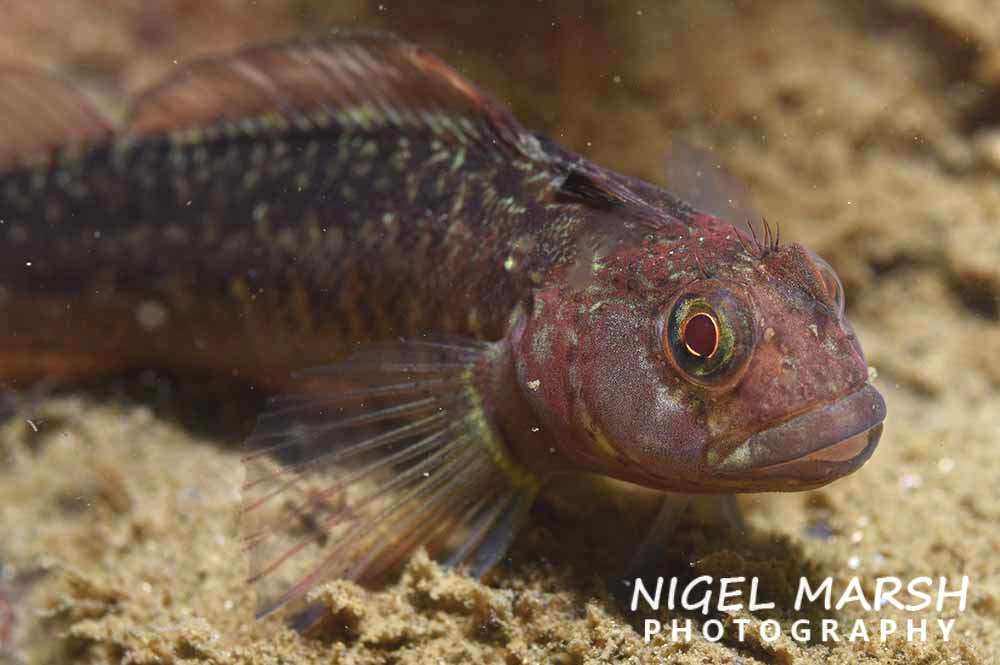Estuarine Threefin, Forsterygion gymnotum Scott 1977
Other Names: Bare-backed Threefin, Estuarine Triplefin, Tasmanian Robust Triplefin

An Estuarine Threefin, Forsterygion gymnotum, in the Derwent River, Hobart, Tasmania, February 2016. Source: Nigel Marsh / iNaturalist.org. License: CC by Attribution-NonCommercial
Summary:
Although the Estuarine Threefin was first described from Tasmania, the species was introduced to Australia from New Zealand, possibly among shipments of live oysters.
Cite this page as:
Bray, D.J. 2019, Forsterygion gymnotum in Fishes of Australia, accessed 21 Apr 2024, https://fishesofaustralia.net.au/Home/species/5460
Estuarine Threefin, Forsterygion gymnotum Scott 1977
More Info
|
Distribution |
Derwent Estuary, Tasmania. Elsewhere the species occurs in New Zealand. Clements et al. (2000) suggested that the species had been introduced to Tasmania via shipments of live oysters from New Zealand. The genetic study of Hickey et al. (2004) provided further evidence of introductions into Tasmania. The species inhabits exposed rocky reefs and turbid coastal waters, often sheltering among encrusting invertebrates. The species is also seen on wharves and jetties covered in encrusting invertebrates. |
|
Features |
Dorsal fin spines (total) 25 - 30; Dorsal soft rays (total): 14-16; Anal spines: 2; Anal soft rays: 25 - 27; Vertebrae: 44 - 46. Snout profile steep, line drawn through tip of premaxilla across ventral margin of orbit touches or passes anterodorsal to dorsal extremity of preoperculum. Transverse groove in front of first dorsal fin containing cephalic sensory pore. Scales absent in front of first dorsal fin first spine, naked immediately adjacent to first dorsal, but many small ctenoid scales adjacent to post-temporal. First lateral line scale with one group of ctenii at upper posterior edge, second scale onward, with two groups of ctenii at upper and middle posterior edges. Dorsal fin formula V-0N-0-1-0-1 |
|
Etymology |
The specific name gynmotum is from Greek words meaning naked and back, in "allusion to the present of a naked, non-scaled area on the back on either side of the base of the first dorsal fin and the early part of the second dorsal". |
|
Species Citation |
Forsterygion gymnotum Scott 1977, Papers and Proceedings of the Royal Society of Tasmania 111: 158, fig. 3. Type locality: Montague Bay, Derwent River, southeastern Tasmania, Australia. |
|
Author |
Bray, D.J. 2019 |
|
Resources |
Estuarine Threefin, Forsterygion gymnotum Scott 1977
References
Clements, K.D. 2014. Forsterygion gymnota. The IUCN Red List of Threatened Species 2014: e.T179022A1560367. http://dx.doi.org/10.2305/IUCN.UK.2014-3.RLTS.T179022A1560367.en. Downloaded on 18 June 2019.
Clements, K.D., Jawad, L.A. & Stewart, A.L. 2000. The New Zealand triplefin Grahamina signata (Teleostei; Tripterygiidae): a junior synonym of G. gymnota from Tasmania. Journal of the Royal Society of New Zealand 30(4): 373-384 https://doi.org/10.1080/03014223.2000.9517629, open access
Edgar, G.J., Last, P.R. & Wells, M.W. 1982. Coastal Fishes of Tasmania and Bass Strait. Hobart : Cat & Fiddle Press 175 pp.
Feary, D.A., Wellenreuther, M. & Clements, K.D. 2009. Trophic ecology of New Zealand triplefin fishes (Family Tripterygiidae). Marine Biology 156: 1703-1714.
Francis, M. 2001. Coastal Fishes of New Zealand. Auckland : Reed Publishing (NZ) 3rd ed., 103 pp.
Fricke, R. 1994. Tripterygiid fishes of Australia, New Zealand and the Southwest Pacific Ocean, with descriptions of 2 new genera and 16 species (Teleostei). Theses Zoologicae 24: 1-585 figs 1-130
Fricke, R. & Roberts, C.D. 1993. Grahamina, a new genus for robust-bodied triplefins (Teleostei : Tripterygiidae) from New Zealand and Australia, with description of a new species. Stuttgarter Beiträge zur Naturkunde. Serie A (Biologie) 504: 1-21 figs 1-9 See ref online
Hardy, G.S. 1989. The genus Forsterygion Whitley & Phillipps, 1939 (Pisces: Tripterygiidae) in New Zealand and Australia, with descriptions of two new species. Journal of Natural History 23(3): 491-512 https://doi.org/10.1080/00222938900770291
Hickey, A.J.R., Lavery, S.D., Hannan, D.A., Baker, C.S. & Clements, K.D. 2004. Verifying invasive marine fish species using molecular techniques: A model example using triplefin fishes (Family Tripterygiidae). New Zealand Journal of Marine and Freshwater Research 38(3): 439-446 https://doi.org/10.1080/00288330.2004.9517251, open access
Hickey, A.J.R., Lavery, S.D., Hannan, D.A., Baker, C.S. & Clements, K.D. 2009. New Zealand triplefin fishes (family Tripterygiidae): contrasting population structure and mtDNA diversity within a marine species flock. Molecular Ecology 18: 680-696. doi:10.1111/j.1365-294X.2008.04052.x
Jawad, L.A. 2008. Second revision of the New Zealand triplefin genus Forsterygion Whitley and Phillips, 1939 (Pisces: Tripterygiidae). Journal of Natural History 42(47-48): 2943-2989 https://doi.org/10.1080/00222930802256842
Last, P.R., Scott, E.O.G. & Talbot, F.H. 1983. Fishes of Tasmania. Hobart : Tasmanian Fisheries Development Authority 563 pp. figs.
Scott, E.O.G. 1977. Observations on some Tasmanian fishes: Part XXIII. Papers and Proceedings of the Royal Society of Tasmania 111: 111-180 figs 1-3 See ref online
Stewart, A.L. & Clements, K.D. 2015. 215 Family Tripterygiidae, pp. 1491-1523 in Roberts, C.D., Stewart, A.L. & Struthers, C.D. (eds) 2015. The Fishes of New Zealand. Wellington : Te Papa Press Vol. 4 pp. 1153-1748.
Wellenreuther, M., Barrett, P.T. & Clements, K.D. 2007. Ecological Diversification In Habitat Use by subtidal triplefins (Tripterygiidae). Marine Ecology Press Series 330: 235-246.


